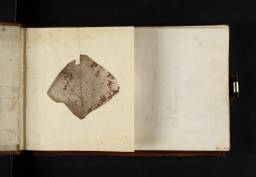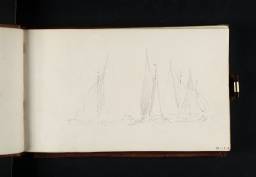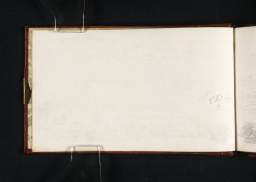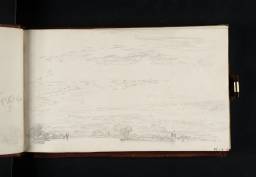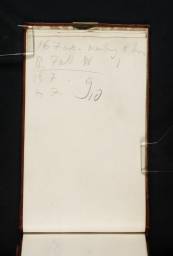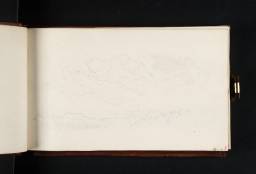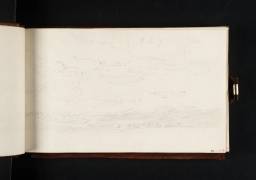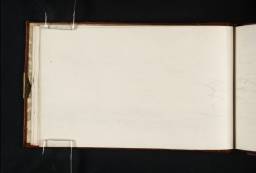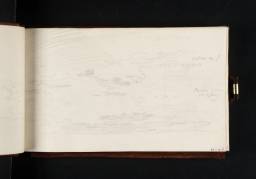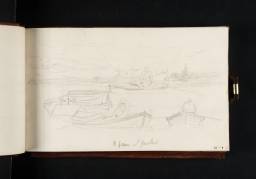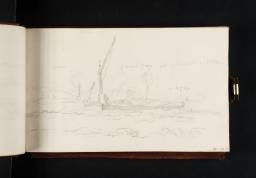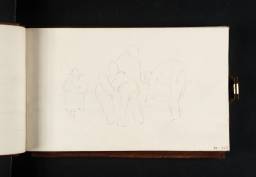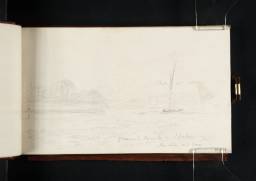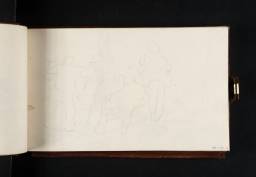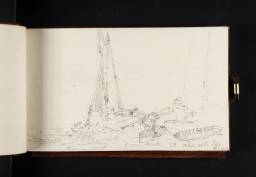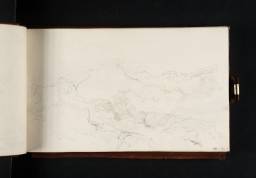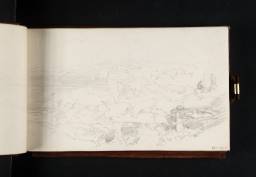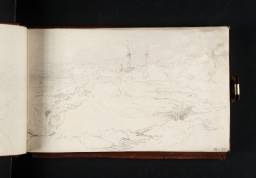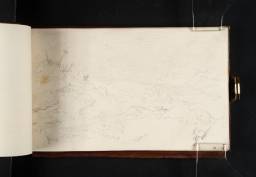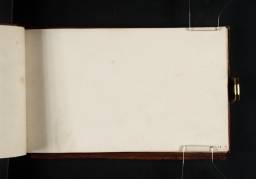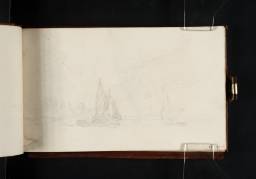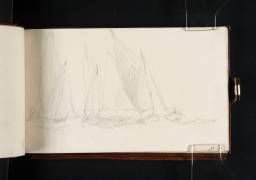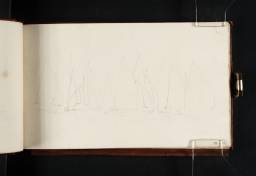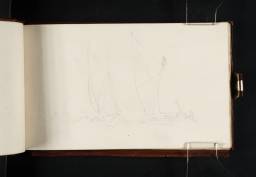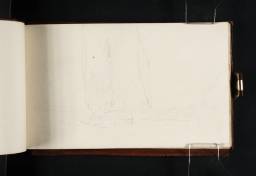Turner Bequest CI
Sketchbook, bound in calf, with one brass clasp, the spine repaired
88 leaves of white wove paper
Approximate page size 107 x 180 mm
Made by William Balston and Finch and Thomas Robert Hollingworth at Turkey Mill, Maidstone, Kent
Watermarked ‘J WHATMAN 1805’
Originally labelled by Turner ‘51. Boats, Ice’
Endorsed by the Executors of the Turner Bequest in ink ‘No.319. Contains 35 Leaves | Pencil sketches’, and signed by Henry Scott Trimmer and Charles Turner in ink ‘H.S. Trimmer’ and ‘C Turner’ and by Charles Eastlake and John Prescott Knight in pencil ‘C.L.E’ and ‘JPK’ inside front cover. Pasted inside front cover is a small piece of paper inscribed by Turner in ink ‘13 ft 6 ins / 4 length | 7ft 9 ins / 4 high’ and by Arthur Mayger Hind in pencil ‘Found with CI but | relation uncertain | AMH.’ A further endorsement by John Ruskin is recorded by Finberg: ‘319. Some precious sky and boat studies. Five leaves cut out’
88 leaves of white wove paper
Approximate page size 107 x 180 mm
Made by William Balston and Finch and Thomas Robert Hollingworth at Turkey Mill, Maidstone, Kent
Watermarked ‘J WHATMAN 1805’
Originally labelled by Turner ‘51. Boats, Ice’
Endorsed by the Executors of the Turner Bequest in ink ‘No.319. Contains 35 Leaves | Pencil sketches’, and signed by Henry Scott Trimmer and Charles Turner in ink ‘H.S. Trimmer’ and ‘C Turner’ and by Charles Eastlake and John Prescott Knight in pencil ‘C.L.E’ and ‘JPK’ inside front cover. Pasted inside front cover is a small piece of paper inscribed by Turner in ink ‘13 ft 6 ins / 4 length | 7ft 9 ins / 4 high’ and by Arthur Mayger Hind in pencil ‘Found with CI but | relation uncertain | AMH.’ A further endorsement by John Ruskin is recorded by Finberg: ‘319. Some precious sky and boat studies. Five leaves cut out’
Accepted by the nation as part of the Turner Bequest 1856
Exhibition history
References
This sketchbook contains river scenes, evidently of the Thames, with barges, fishing and sailing boats, sketches of the sky, passages of Turner’s verse, and studies of vessels trapped in ice which account for the name given to the book by Turner. If these last are imaginary, there would be no reason to date the sketchbook differently from most of the others containing Thames material, or to diverge from Finberg’s date range of 1806–8. If however they record Turner’s actual observations, they can only have been drawn during the great frost of January 1814 (the last of its kind) when the Thames was deeply frozen. They may therefore have been added later to a book which had already seen some use.
Commentators have been divided on the status of the frost scenes. In Sketches and Drawings Finberg thought they were ‘evidently made during a severe winter’ and proved that Turner ‘was no mere fair weather sailor’. The 1974 Royal Academy catalogue noted the 1814 freeze but described them as ‘presumably imaginary’ while Gerald Wilkinson asked ‘can this be the Thames Estuary?... Smelt, and pack-ice, are not typical of the mouth of the Thames’. Most recently Anthony Bailey has accepted them as direct reportage from the time when Turner lodged at 6, West End Hammersmith, but in fact there were no such extreme frosts during Turner’s time there and he had left that address by the winter of 1811. Perhaps a cold snap prompted Turner to imagine something more dramatic.
There is a clear difference between the calm scene of the frozen Thames with a single barge on folio 12 (D06631) and the two sketches of ships stuck in mountainous peaks of ice on folios 17 and 18 (D06636, D06637). The latter, for part of the time it was exhibited at Oxford, was said by Ruskin to depict ‘The Inscrutable!’, and one wonders what, if any, might be the link with a drawing by Alexander Cozens, said to represent a shipwreck but just as likely to show a ship caught in ice, and also once known as ‘The Inscrutable’ (Tate T08772); with a stormy sky and lightning, this is clearly an elemental fantasy but may also evoke some tradition or story forgotten today. This catalogue further suggests that, if this title did not originate with Cozens himself, it could have been inspired by Ruskin’s naming of Turner’s drawing.
Another possibility, perhaps arguing for an earlier date, is that these drawings are connected with Turner’s musings on the death of the explorer Hugh Willoughby, trapped in ice off Murmansk while on a voyage (begun in 1553) to find a North-East Passage to China and India, sponsored by the Company of Merchant Adventurers. In verses in his Greenwich sketchbook of circa 1808–10 (Tate D06721–D06829; D40666–D40668; Turner Bequest CII) Turner wrote of ‘The daring Willoughby’ who ‘in frozen regions died’, and described an icy sea; ‘In repercussive roar the frost bound ocean sounds’. Two watercolour vignettes from the 1830s (private collection; and with W/S Fine Art, London, 2007), hitherto usually associated with the whaling industry, may be later variations on this theme.1
By way of various chains of association – weather and seasons, the Thames, British commerce, enterprise, culture and national pride – these ideas became linked in Turner’s mind to the poet Alexander Pope, and the demolition of his villa at Twickenham in 1807 on the orders of Baroness Howe. In this sketchbook, from folio 85 verso (D06709) to the inner back cover (D06618), are verses more specifically about this demolition, which Turner saw as an act of cultural vandalism. They are drafts for Turner’s poem ‘On the Demolition of Pope-House at Twickenham’ in his Verse Book (private collection),2 more advanced than those in the River sketchbook of circa 1806–8 (Tate D05961–D06071; D40650–D40654; Turner Bequest XCVI). Dimensions jotted on folio 5 verso (D06224) and on a piece of paper attached to the inner front cover may relate to Turner’s plans for Sandycombe Lodge, his house at Twickenham built around 1812 on land bought in 1807; extrapolating from Turner’s poem, Patrick Youngblood has suggested that Turner saw his own house as symbolically preserving the memory of Pope’s.3
Technical Notes
How to cite
David Blayney Brown, ‘Boats, Ice sketchbook c.1806–14’, sketchbook, December 2006, in David Blayney Brown (ed.), J.M.W. Turner: Sketchbooks, Drawings and Watercolours, Tate Research Publication, December 2012, https://www

